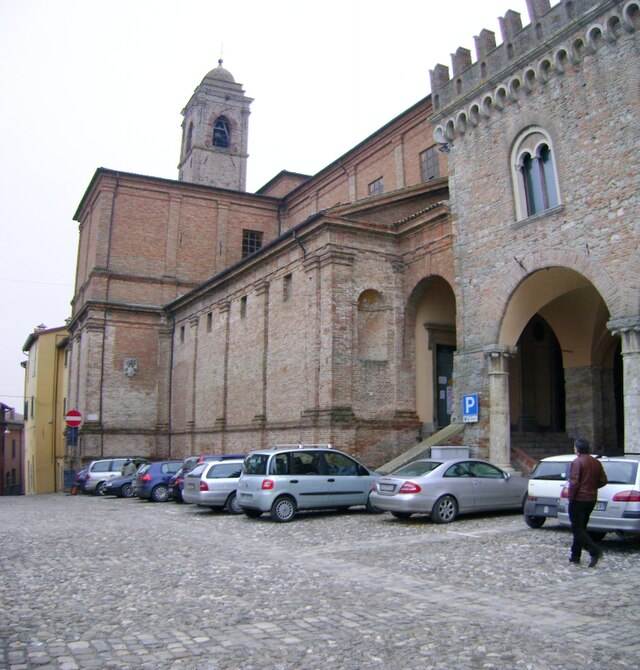Roman Catholic Diocese of Forlì-Bertinoro
Roman Catholic diocese in Italy From Wikipedia, the free encyclopedia
Roman Catholic diocese in Italy From Wikipedia, the free encyclopedia
The Diocese of Forlì-Bertinoro (Latin: Dioecesis Foroliviensis-Brittinoriensis) is a Latin diocese of the Catholic Church in Romagna, Italy. Until 1986 it was known as the Diocese of Forlì, in existence perhaps from the fourth century. In that year the Diocese of Bertinoro was united to it. The diocese is suffragan to the Archdiocese of Ravenna-Cervia.[1]
Diocese of Forlì-Bertinoro Dioecesis Foroliviensis-Brittinoriensis | |
|---|---|
 | |
| Location | |
| Country | Italy |
| Ecclesiastical province | Ravenna-Cervia |
| Statistics | |
| Area | 1,182 km2 (456 sq mi) |
| Population - Total - Catholics | (as of 2016) 189,400 (est.) 178,000 (est.) (94.0%) |
| Parishes | 128 |
| Information | |
| Denomination | Catholic Church |
| Rite | Roman Rite |
| Established | 4th century ? |
| Cathedral | Cattedrale di S. Croce (Forlì) |
| Co-cathedral | Concattedrale di S. Caterina (Bertinoro) |
| Secular priests | 93 (diocesan) 19 (Religious Orders) 11 Permanent Deacons |
| Current leadership | |
| Pope | Francis |
| Bishop | Livio Corazza |
| Bishops emeritus | Vincenzo Zarri Lino Pizzi |
| Website | |
| www.diocesiforli.it | |
This section needs expansion with: any historical information. You can help by adding to it. (October 2016) |
St. Mercurialis is considered the first bishop of Forlì, and has been said to belong to the second century; he is also said to be the Mercurialis who was allegedly present at the Council of Rimini in 359. Both assertions are based on legends of the 11th or 12th century.[2]
On 12 July 1173, a major fire destroyed nearly all of the city of Forlì, including the episcopal palace, the cathedral with its annexes, the other churches, and the monastery of S. Mercuriale, which housed the archives.[3] In 1353, another large fire destroyed the district of S. Mercuriale in Forlì and damaged large parts of the rest of the city.[4]
On 8 July 1286, Archbishop Bonifacio Fieschi de' Conti di Lavagna of Ravenna presided over a provincial council, held in Forlì. It was attended by the bishops of Imola, Faenza, Forlimpopoli, Ceseena, Sarsina, Adria, and Bishop Rinaldus of Forlì, as well as procurators of the bishops of Bologna, Cervia, Modena, and Parma.[5]
In 1769, the Cathedral of the cathedral of the Holy Cross was staffed and administered by a Chapter, consisting of four dignities (not dignitaries) and nineteen Canons.[6] The dignities were: the Provost, the Archpriest, the Archdeacon, and the Primicerius."[7]
Bishop Giacomo Theodoli (1635–1665) held his second diocesan synod in Forlì on 5 May 1639. He had previously held a synod, at some time between 1635 and 1639.[8] Bishop Claudio Ciccolini (1666–1688) held a diocesan synod on 22 April 1675.[9]
The Second Vatican Council (1962–1965), in order to ensure that all Catholics received proper spiritual attention, decreed the reorganization of the diocesan structure of Italy and the consolidation of small and struggling dioceses.[10] These considerations applied to Forlì and Bertinoro. Forlì claimed a Catholic population of 178,000, with 112 priests. Bertinoro, in 1980 had only 37,650 Catholics, but 64 priests.
On 18 February 1984, the Vatican and the Italian State signed a new and revised concordat. Based on the revisions, a set of Normae was issued on 15 November 1984, which was accompanied in the next year, on 3 June 1985, by enabling legislation. According to the agreement, the practice of having one bishop govern two separate dioceses at the same time, aeque personaliter, was abolished. This applied to Bishop Giovanni Proni, who had been Bishop of Bertinoro since 10 March 1970, and at the same time Bishop of Forlì since 9 June 1976.
Instead, the Vatican continued consultations which had begun under Pope John XXIII for the merging of small dioceses, especially those with personnel and financial problems, into one combined diocese. On 30 September 1986, Pope John Paul II ordered that the dioceses of Forlì and Bertinoro be merged into one diocese with one bishop, with the Latin title Dioecesis Foroliviensis-Brittinoriensis. The seat of the diocese was to be in Forlì, and the cathedral of Forli was to serve as the cathedral of the merged dioceses. The cathedral in Bertinoro was to become a co-cathedral, and the cathedral Chapter was to be a Capitulum Concathedralis. Bertinoro which was established in 1360, has its own unique history. It was created after the destruction of Forlimpopoli by Cardinal Albornoz. There was to be only one diocesan Tribunal, in Forlì, and likewise one seminary, one College of Consultors, and one Priests' Council. The territory of the new diocese was to include the territory of the former diocese of Bertinoro.[11]

United: 30 September 1986 with the Diocese of Bertinoro
Seamless Wikipedia browsing. On steroids.